A bimble through Trengwainton Gardens
I spent this morning online working on a couple of projects - but by late afternoon I needed a screen break and some fresh air. I decided to make use of my National Trust Volunteer Card which gives me free entry to a number of places closeby. I payed a visit to Trengwainton Gardens just a couple of miles the other side of Penzance. It was a good way to spend a late Sunday afternoon. I took a few pictures to show you around....
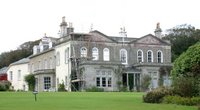 Trengwainton Gardens is a National Trust property that covers nearly 100 acres of shrub garden, bog garden and walled gardens, which overlook Mount's Bay. It climbs gently uphill for a third of a mile following a little stream.
Trengwainton Gardens is a National Trust property that covers nearly 100 acres of shrub garden, bog garden and walled gardens, which overlook Mount's Bay. It climbs gently uphill for a third of a mile following a little stream.

The garden faces due south and has a gentle micro-climate which experiences very few hard frosts. This creates the conditions needed to cultivate the rich collection of rhododendrons, magnolias, camellias and many tender and half-hardy species that cannot be grown in the open anywhere else in England.
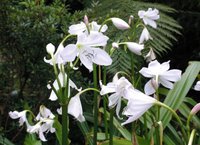 Trengwainton is largely a 20th century creation although there has been a house here at least since the 16th century. Lieutenant Colonel Sir Edward Bolitho, whose family came here in 1857, began work on the garden after he inherited the rambling Victorian house in 1925.
Trengwainton is largely a 20th century creation although there has been a house here at least since the 16th century. Lieutenant Colonel Sir Edward Bolitho, whose family came here in 1857, began work on the garden after he inherited the rambling Victorian house in 1925.
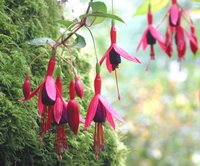 Graham Stuart Thomas wrote that 'Sir Edward gardened, as he used to say, "above the knee", which was his way of informing one that lowly plants did not interest him. In fact he would walk regardlessly through primroses, cyclamens and daffodils to point out to me yet another of his special treasures'.
Graham Stuart Thomas wrote that 'Sir Edward gardened, as he used to say, "above the knee", which was his way of informing one that lowly plants did not interest him. In fact he would walk regardlessly through primroses, cyclamens and daffodils to point out to me yet another of his special treasures'.
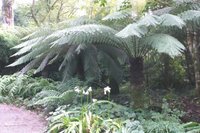 The tortuous paths overhung with Australian Dicksonia tree ferns give it an intimate Jurassic feel. The rhododendrons are ideally suited to the acid soil here.
The tortuous paths overhung with Australian Dicksonia tree ferns give it an intimate Jurassic feel. The rhododendrons are ideally suited to the acid soil here.
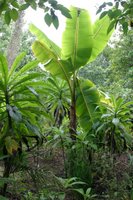
The framework of the garden dates back to the early 19th century when Rose Price, the son of a wealthy West Indian sugar planter, planted a series of tall beech trees and oaks along the line of the stream creating a structure for the garden and giving shelter to the family home; protecting Trengwainton from westerly gales.
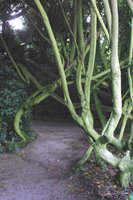 At this time of year the the garden is a soothing warren of deep green that tunnels through feathery bamboo, eucalyptus and fern fronds which line the course of the stream.
At this time of year the the garden is a soothing warren of deep green that tunnels through feathery bamboo, eucalyptus and fern fronds which line the course of the stream.
Lillies and fuchsia punctuate the lush gloom with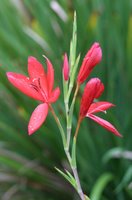 splashes of white red, pink and purple and hydrangea fill patches of the understorey with pale blue.
splashes of white red, pink and purple and hydrangea fill patches of the understorey with pale blue.
 Paths lead up to a terrace and summer houses with stunning views across Mount's Bay to The Lizard.
Paths lead up to a terrace and summer houses with stunning views across Mount's Bay to The Lizard.
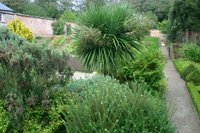 Price used much of his income from the Jamaican plantations to create the unusual walled garden, remodelling the contours of the land, creating terraces, along the south and west facing slopes of the hillside. He used brick, a warmer but more expensive material than the local granite, to build a series of compartments.
Price used much of his income from the Jamaican plantations to create the unusual walled garden, remodelling the contours of the land, creating terraces, along the south and west facing slopes of the hillside. He used brick, a warmer but more expensive material than the local granite, to build a series of compartments.
 The dividing walls between each separate garden have a steeply sloped bed of banked-up soil on their western side. This is a rare survival of a practice that was common in the late 18th and early 19th centuries. The south- and west-facing slopes receive the full benefit of the sun. Here early crops of vegetables are produced and tender plants cultivated.
The dividing walls between each separate garden have a steeply sloped bed of banked-up soil on their western side. This is a rare survival of a practice that was common in the late 18th and early 19th centuries. The south- and west-facing slopes receive the full benefit of the sun. Here early crops of vegetables are produced and tender plants cultivated.
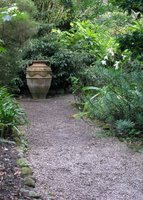 Each compartment has a small lawn, surrounded by borders filled with tender species of shrub and plants including camellias, passionflowers and rhododendrons collected on an expedition to the Himalayas in 1927-8; which Lt. Col. Sir Edward Bolitho partially funded.
Each compartment has a small lawn, surrounded by borders filled with tender species of shrub and plants including camellias, passionflowers and rhododendrons collected on an expedition to the Himalayas in 1927-8; which Lt. Col. Sir Edward Bolitho partially funded.
 I drove back through Penzance out of curiousity. Despite a plethora of B&Bs , a bingo hall, a pirate souvenir shop and other trappings of a seaside resort town, its does seem to hold onto its original character as a functional port. The view of St Michaels Mount haunts the bay and no doubt makes the recently developed apartments on the front highly desirable real estate.
I drove back through Penzance out of curiousity. Despite a plethora of B&Bs , a bingo hall, a pirate souvenir shop and other trappings of a seaside resort town, its does seem to hold onto its original character as a functional port. The view of St Michaels Mount haunts the bay and no doubt makes the recently developed apartments on the front highly desirable real estate.
 Trengwainton Gardens is a National Trust property that covers nearly 100 acres of shrub garden, bog garden and walled gardens, which overlook Mount's Bay. It climbs gently uphill for a third of a mile following a little stream.
Trengwainton Gardens is a National Trust property that covers nearly 100 acres of shrub garden, bog garden and walled gardens, which overlook Mount's Bay. It climbs gently uphill for a third of a mile following a little stream.
The garden faces due south and has a gentle micro-climate which experiences very few hard frosts. This creates the conditions needed to cultivate the rich collection of rhododendrons, magnolias, camellias and many tender and half-hardy species that cannot be grown in the open anywhere else in England.
 Trengwainton is largely a 20th century creation although there has been a house here at least since the 16th century. Lieutenant Colonel Sir Edward Bolitho, whose family came here in 1857, began work on the garden after he inherited the rambling Victorian house in 1925.
Trengwainton is largely a 20th century creation although there has been a house here at least since the 16th century. Lieutenant Colonel Sir Edward Bolitho, whose family came here in 1857, began work on the garden after he inherited the rambling Victorian house in 1925. Graham Stuart Thomas wrote that 'Sir Edward gardened, as he used to say, "above the knee", which was his way of informing one that lowly plants did not interest him. In fact he would walk regardlessly through primroses, cyclamens and daffodils to point out to me yet another of his special treasures'.
Graham Stuart Thomas wrote that 'Sir Edward gardened, as he used to say, "above the knee", which was his way of informing one that lowly plants did not interest him. In fact he would walk regardlessly through primroses, cyclamens and daffodils to point out to me yet another of his special treasures'. The tortuous paths overhung with Australian Dicksonia tree ferns give it an intimate Jurassic feel. The rhododendrons are ideally suited to the acid soil here.
The tortuous paths overhung with Australian Dicksonia tree ferns give it an intimate Jurassic feel. The rhododendrons are ideally suited to the acid soil here.
The framework of the garden dates back to the early 19th century when Rose Price, the son of a wealthy West Indian sugar planter, planted a series of tall beech trees and oaks along the line of the stream creating a structure for the garden and giving shelter to the family home; protecting Trengwainton from westerly gales.
 At this time of year the the garden is a soothing warren of deep green that tunnels through feathery bamboo, eucalyptus and fern fronds which line the course of the stream.
At this time of year the the garden is a soothing warren of deep green that tunnels through feathery bamboo, eucalyptus and fern fronds which line the course of the stream.Lillies and fuchsia punctuate the lush gloom with
 splashes of white red, pink and purple and hydrangea fill patches of the understorey with pale blue.
splashes of white red, pink and purple and hydrangea fill patches of the understorey with pale blue. Paths lead up to a terrace and summer houses with stunning views across Mount's Bay to The Lizard.
Paths lead up to a terrace and summer houses with stunning views across Mount's Bay to The Lizard. Price used much of his income from the Jamaican plantations to create the unusual walled garden, remodelling the contours of the land, creating terraces, along the south and west facing slopes of the hillside. He used brick, a warmer but more expensive material than the local granite, to build a series of compartments.
Price used much of his income from the Jamaican plantations to create the unusual walled garden, remodelling the contours of the land, creating terraces, along the south and west facing slopes of the hillside. He used brick, a warmer but more expensive material than the local granite, to build a series of compartments. The dividing walls between each separate garden have a steeply sloped bed of banked-up soil on their western side. This is a rare survival of a practice that was common in the late 18th and early 19th centuries. The south- and west-facing slopes receive the full benefit of the sun. Here early crops of vegetables are produced and tender plants cultivated.
The dividing walls between each separate garden have a steeply sloped bed of banked-up soil on their western side. This is a rare survival of a practice that was common in the late 18th and early 19th centuries. The south- and west-facing slopes receive the full benefit of the sun. Here early crops of vegetables are produced and tender plants cultivated. Each compartment has a small lawn, surrounded by borders filled with tender species of shrub and plants including camellias, passionflowers and rhododendrons collected on an expedition to the Himalayas in 1927-8; which Lt. Col. Sir Edward Bolitho partially funded.
Each compartment has a small lawn, surrounded by borders filled with tender species of shrub and plants including camellias, passionflowers and rhododendrons collected on an expedition to the Himalayas in 1927-8; which Lt. Col. Sir Edward Bolitho partially funded. I drove back through Penzance out of curiousity. Despite a plethora of B&Bs , a bingo hall, a pirate souvenir shop and other trappings of a seaside resort town, its does seem to hold onto its original character as a functional port. The view of St Michaels Mount haunts the bay and no doubt makes the recently developed apartments on the front highly desirable real estate.
I drove back through Penzance out of curiousity. Despite a plethora of B&Bs , a bingo hall, a pirate souvenir shop and other trappings of a seaside resort town, its does seem to hold onto its original character as a functional port. The view of St Michaels Mount haunts the bay and no doubt makes the recently developed apartments on the front highly desirable real estate.


1 Comments:
Glad you enjoyed Trengwainton - it is a rather special place. As in Penwith as a whole. I am, of course, biased, as my grandmother was a Bolitho, and, although I was raised in Devon, I love the energy of Penwith. Zen
Post a Comment
<< Home